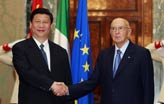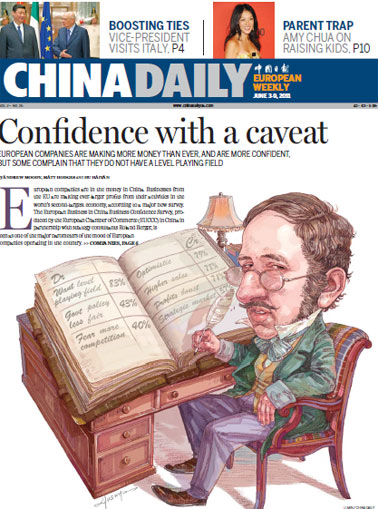Op-Ed Contributors
China's policy a wake-up call for the US
Updated: 2011-06-08 07:56
By Dieter Ernst (China Daily)
Only a few years ago, China's approach to innovation barely played a role in international economic diplomacy. Today, China's innovation policy and its perceived threat to the US economy are a hot topic in US-China economic relations, adding to contentious disputes about exchange rates, trade and foreign direct investment.
When Chinese President Hu Jintao visited the United States in January, public debate focused on widespread fears that China's emerging role in hi-tech innovation will challenge the US' leadership in the global knowledge economy.
That China's innovation policy unfairly favors domestic producers and poses a threat to global intellectual property protection; that it is used as a trade-distorting ploy against US exports; and that it forces US companies to offshore good jobs in engineering, product development and research were among some of the concerns expressed.
A recent report by the US Chamber of Commerce claims that China's innovation policy is "a blueprint for technology theft on a scale the world has never seen before."
But how serious a challenge does China's innovation push really pose to the US?
Based on research on China's evolving innovation capacity, I would strongly argue against such exaggerated fears, which are sometimes played up for political purposes. Instead, China's rise should serve as a wake-up call that we need to bring our own house in order.
China's speed in catching up in innovation has been truly impressive. Since 2000, research and development spending has increased roughly 10 percent each year - a pace the country maintained even during the 2008-2009 recession.
China's share in global R&D spending has increased from 9.1 percent in 2008 to 12.3 percent in 2010, while the US' share has declined from 35.4 percent to 34.4 percent. This year, China's share is projected to further grow to 12.9 percent, overtaking Japan as the world's second largest R&D investor. And China's share in the global pool of researchers has increased from less than 14 percent in 2002 to more than 20 percent today.
In addition, China's science and technology publications have rapidly expanded in critical areas like nanotechnology and life sciences, as have patent applications by Chinese residents both at home and overseas. China has clearly become a serious competitor, not only in price but also in technology.
There is no doubt, however, that barriers to innovation remain substantial, ranging from severe quality problems in education to plagiarism in science, and barriers to entrepreneurship and private R&D investment. A comparison with US indicators demonstrates that China still has a long way to go to close the innovation gap.
In short, the US retains a strong lead in overall innovative capacity, and Chinese firms will continue to need access to US technology across a broad spectrum of industries and services. China's innovation push can thus create new markets for US firms, provided they stay ahead on the innovation curve.
Both the US and China share a fundamental objective - they seek to enhance international competitiveness in the dramatically altered post-crisis environment. Both governments see innovation as the necessary catalyst for a sustainable recovery that will last beyond short-term stimulus packages. For China's government, strengthening the domestic capacity for innovation is the key to a transformation of its economy beyond the export-oriented "global factory" model.
The defining characteristic of China's innovation policy is a focus on "indigenous innovation" to redress its weak record of firm-level innovation in technologies that address China's fundamental development needs. Specifically, the plan calls for utilizing science and technology to lead future economic growth, especially in energy, water and resource utilization, environmental protection and public health. The plan also calls for "leapfrogging" to research frontiers in key scientific disciplines, such biotechnology and nanotechnology.
China's effort to strengthen its innovation capacity should not come as a surprise. It is part and parcel of intensified technology-centered competition on a global scale. Like the US, China has no choice but to participate in a global "innovation race" in which no country dares to fall behind the others in the creation of new products and processes.
Furthermore, innovation policy nearly everywhere has been tarred with a protectionist brush, as demonstrated by persistent trade conflicts between the US and the European Union in such industries as telecommunications, aerospace, defense and life sciences. What distinguishes China is that the implementation of its innovation policy is still shaped by the legacy of the centrally planned economy.
An analysis of China's recent policy initiatives and its response to foreign complaints shows signs of gradual, if uneven, progress toward greater pragmatism and less market regulation. While technology-related trade conflicts will continue, it may now be possible to transform technology-centered competition between both countries into a positive-sum game that benefits both sides.
However, this requires that policies go beyond trade conflicts and address long-term strategic issues. To take advantage of the opportunities offered by China's innovation push, the US government and private sector need to join forces to develop a national strategy that will enhance innovative capacity and create quality jobs in research, product development and engineering.
The author is a senior research fellow in economics at the East-West Center in Honolulu. He can be reached at ErnstD@EastWestCenter.org.
E-paper

Harbin-ger of change
Old industrial center looks to innovation to move up the value chain
Chemical attraction
The reel Mao
Improving app-iness
Specials

Vice-President visits Italy
The visit is expected to lend new impetus to Sino-Italian relations.

Birthday a new 'starting point'
China's national English language newspaper aims for a top-notch international all-media group.

Sky is the limit
Chinese tycoon conjures up green dreams in Europe with solar panels
